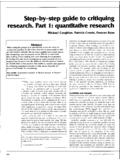Transcription of © Joanna Briggs Institute 2017 Critical Appraisal ...
1 The Joanna Briggs Institute Critical Appraisal tools for use in JBI Systematic Reviews Checklist for Systematic Reviews and Research Syntheses Joanna Briggs Institute 2017 Critical Appraisal Checklist for Systematic Reviews and Research Syntheses 2 The Joanna Briggs Institute Introduction The Joanna Briggs Institute (JBI) is an international, membership based research and development organization within the Faculty of Health Sciences at the University of Adelaide. The Institute specializes in promoting and supporting evidence-based healthcare by providing access to resources for professionals in nursing, midwifery, medicine, and allied health. With over 80 collaborating centres and entities, servicing over 90 countries, the Institute is a recognized global leader in evidence-based healthcare.
2 JBI Systematic Reviews The core of evidence synthesis is the systematic review of literature of a particular intervention, condition or issue. The systematic review is essentially an analysis of the available literature (that is, evidence) and a judgment of the effectiveness or otherwise of a practice, involving a series of complex steps. The JBI takes a particular view on what counts as evidence and the methods utilized to synthesize those different types of evidence. In line with this broader view of evidence, the Institute has developed theories, methodologies and rigorous processes for the Critical Appraisal and synthesis of these diverse forms of evidence in order to aid in clinical decision-making in health care. There now exists JBI guidance for conducting reviews of effectiveness research, qualitative research, prevalence/incidence, etiology/risk, economic evaluations, text/opinion, diagnostic test accuracy, mixed-methods, umbrella reviews and scoping reviews.
3 Further information regarding JBI systematic reviews can be found in the JBI Reviewer s Manual on our website. JBI Critical Appraisal Tools All systematic reviews incorporate a process of critique or Appraisal of the research evidence. The purpose of this Appraisal is to assess the methodological quality of a study and to determine the extent to which a study has addressed the possibility of bias in its design, conduct and analysis. All papers selected for inclusion in the systematic review (that is those that meet the inclusion criteria described in the protocol) need to be subjected to rigorous Appraisal by two Critical appraisers. The results of this Appraisal can then be used to inform synthesis and interpretation of the results of the study. JBI Critical Appraisal tools have been developed by the JBI and collaborators and approved by the JBI Scientific Committee following extensive peer review.
4 Although designed for use in systematic reviews, JBI Critical Appraisal tools can also be used when creating Critically Appraised Topics (CAT), in journal clubs and as an educational tool. Joanna Briggs Institute 2017 Critical Appraisal Checklist for Systematic Reviews and Research Syntheses 3 JBI Critical Appraisal Checklist for Systematic Reviews and Research Syntheses Reviewer Date Author Year Record Number Yes No Unclear Not applicable 1. Is the review question clearly and explicitly stated? 2. Were the inclusion criteria appropriate for the review question? 3. Was the search strategy appropriate? 4. Were the sources and resources used to search for studies adequate? 5. Were the criteria for appraising studies appropriate?
5 6. Was Critical Appraisal conducted by two or more reviewers independently? 7. Were there methods to minimize errors in data extraction? 8. Were the methods used to combine studies appropriate? 9. Was the likelihood of publication bias assessed? 10. Were recommendations for policy and/or practice supported by the reported data? 11. Were the specific directives for new research appropriate? Overall Appraisal : Include Exclude Seek further info Comments (Including reason for exclusion) Joanna Briggs Institute 2017 Critical Appraisal Checklist for Systematic Reviews and Research Syntheses 4 JBI Critical Appraisal Checklist for Systematic Reviews and Research Syntheses How to cite: Aromataris E, Fernandez R, Godfrey C, Holly C, Kahlil H, Tungpunkom P.
6 Summarizing systematic reviews: methodological development, conduct and reporting of an Umbrella review approach. Int J Evid Based Healthc. 2015;13(3):132-40. When conducting an umbrella review using the JBI method, the Critical Appraisal instrument for Systematic Reviews should be used. The primary and secondary reviewer should discuss each item in the Appraisal instrument for each study included in their review. In particular, discussions should focus on what is considered acceptable to the aims of the review in terms of the specific study characteristics. When appraising systematic reviews this discussion may include issues such as what represents an adequate search strategy or appropriate methods of synthesis. The reviewers should be clear on what constitutes acceptable levels of information to allocate a positive Appraisal compared with a negative, or response of unclear.
7 This discussion should ideally take place before the reviewers independently conduct the Appraisal . Within umbrella reviews, quantitative or qualitative systematic reviews may be incorporated, as well as meta-analyses of existing research. There are 11 questions to guide the Appraisal of systematic reviews or meta-analyses. Each question should be answered as yes , no , or unclear . Not applicable NA is also provided as an option and may be appropriate in rare instances. 1. Is the review question clearly and explicitly stated? The review question is an essential step in the systematic review process. A well-articulated question defines the scope of the review and aids in the development of the search strategy to locate the relevant evidence. An explicitly stated question, formulated around its PICO (Population, Intervention, Comparator, Outcome) elements aids both the review team in the conduct of the review and the reader in determining if the review has achieved its objectives.
8 Ideally the review question should be articulated in a published protocol; however this will not always be the case with many reviews that are located. Joanna Briggs Institute 2017 Critical Appraisal Checklist for Systematic Reviews and Research Syntheses 5 2. Were the inclusion criteria appropriate for the review question? The inclusion criteria should be identifiable from, and match the review question. The necessary elements of the PICO should be explicit and clearly defined. The inclusion criteria should be detailed and the included reviews should clearly be eligible when matched against the stated inclusion criteria. Appraisers of meta-analyses will find that inclusion criteria may include criteria around the ability to conduct statistical analyses which would not be the norm for a systematic review.
9 The types of included studies should be relevant to the review question, for example, an umbrella review aiming to summarize a range of effective non-pharmacological interventions for aggressive behaviors amongst elderly patients with dementia will limit itself to including systematic reviews and meta-analyses that synthesize quantitative studies assessing the various interventions; qualitative or economic reviews would not be included. 3. Was the search strategy appropriate? A systematic review should provide evidence of the search strategy that has been used to locate the evidence. This may be found in the methods section of the review report in some cases, or as an appendix that may be provided as supplementary information to the review publication. A systematic review should present a clear search strategy that addresses each of the identifiable PICO components of the review question.
10 Some reviews may also provide a description of the approach to searching and how the terms that were ultimately used were derived, though due to limits on word counts in journals this may be more the norm in online only publications. There should be evidence of logical and relevant keywords and terms and also evidence that Subject Headings and Indexing terms have been used in the conduct of the search. Limits on the search should also be considered and their potential impact; for example, if a date limit was used, was this appropriate and/or justified? If only English language studies were included, will such a language bias have an impact on the review? The response to these considerations will depend, in part, on the review question. 4. Were the sources and resources used to search for studies adequate?









